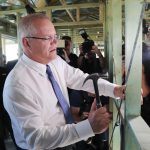Establishing a consensus of what’s fair and reasonable for all
Probably no politician would explicitly advocate unfairness – but what exactly is fair, just and equitable? Dr Neil Byron says we need a broad-based discussion of what we want our society, economy and environment to look like in the next 50 years.
I think both sides of the political spectrum would agree on the desirability of some basic issues. The difference is in the emphasis or priority and, more importantly, the means of achieving great health, education and well-being outcomes.
I am not aware of any politicians who explicitly advocate UNFAIRNESS or deliberately attempt to harm the well-being of most Australian voters – but they have profoundly different views on what’s best for society, especially in long term public interest versus short-term gratification.
Fairness is one of the most frequently used and misused terms in the Australian lexicon (and is never defined, as if “everyone knows what it means”). The fact is that there are many different and valid definitions of fair, just and equitable.
It seems to me that much of the conflict (and often an accompanying sense of injustice) is about different perceptions of what is fair and just – usually (perhaps always) different groups within society have very different, but equally valid, perceptions of what “fair” and “just and equitable” mean.
A few years ago an Indian philosopher gave me an example of the “5 Ps” in allocation of resources within a village:
Parity = everyone gets exactly equal shares
Precedence = elites are “entitled” to a bigger than average share because after all, they ARE the elites!
Performance = those who have worked hard deserve a bigger than average share – they’ve earned it – and those who are lazy deserve less than average
Priority = the poor, the widows, the orphans and landless NEED a bigger than average share because they are so disadvantaged, that they must get priority in the name of fairness
Potluck = hold a large (but statistically perfectly fair) lottery for everything in the village, winner take all, but everyone has an equal probability of winning! Perfectly fair ex ante, but perfectly unfair ex poste.
Each one of these five definitions can be called “fair and reasonable” on some basis, but the actual distributions resulting from each definition differ wildly.
If different parts of the “community” are using completely different definitions of “fair and reasonable”, of course there will be conflict about outcomes (as well as process).
The solution is to find/create a process that establishes a broadly-shared consensus of which of these definitions we (as a society) will operate under! What typically happens is that the state bureaucracy or politicians are using one definition and some of the voters are using other, conflicting definitions – they all THINK they are being “fair and reasonable” (and so they wrongly think that there is no need to discuss/debate this aspect), but they are actually heading in different directions.
There are three quite different Australian societies – what we are, what we imagine that we are, and what we believe we could/should be.
We need to dispose of a few myths in how we see ourselves e.g. that we are a nation of Chips Rafferty/Crocodile Dundee types: heroic, rugged, self-reliant and classless individuals; that everybody can get on if she/he works hard enough etc. It seems to me that many people today are more concerned about THEIR OWN rights and entitlements (what the government owes me) rather than how they can contribute to making the whole society a better place.
These are some of the elements that needs to be part of a broad-based discussion of what we want our society, economy and environment to look like in the next 50 years.
Dr Neil Byron works on policy and socio-economic aspects of natural resources, rural development and the environment.












